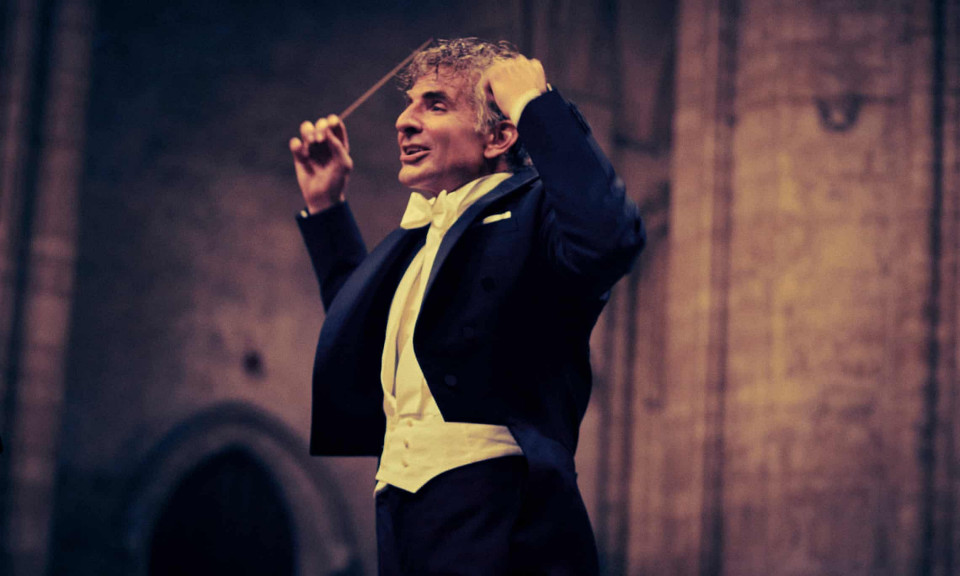Musical Musings on Maestro

Bradley Cooper as the legendary conductor Leonard Bernstein (1918–1990) Jason McDonald/Netflix
“A work of art does not answer questions, it provokes them; and its essential meaning is in the tension between the contradictory answers.” – Leonard Bernstein
This quote that opens Bradley Cooper’s sweeping new biopic on Leonard Bernstein perfectly encapsulates both the film and the man at its heart. In Maestro, Bernstein is simultaneously the hero and the villain, loveable and loathsome, godlike and all-too human. In the film, he articulates this internal tension of not wanting to be just one thing in either his personal life or in music.
Early in his career, Bernstein was told to focus on either conducting or composing—that writing for Broadway would taint his reputation as “the first great American conductor.” But his love of music was so all-encompassing that he could not limit himself to one expression, be it composing, performing, conducting, or teaching. Equal to his love of music was his love of people (or fear of being alone), which manifested similarly, as he had relationships with both men and women throughout his life, including during his 27-year marriage to Felicia Montealegre.
Rather than being a traditional biopic charting Bernstein’s life and accomplishments, Maestro uses his biography as a backdrop against which the drama of the unique love story between Bernstein and Felicia plays out. While some ardent classical music fans may be disappointed at the seemingly secondary role Bernstein’s music plays in the film, the direction Cooper decided to take with the film in centering Felicia (played by Carey Mulligan) sheds new light on the complicated man.
This is not to say that music isn’t vital to the story. Cooper, as writer, director, producer, and star of the film, largely uses Bernstein’s own compositions as the soundtrack for the film. When people think of Bernstein’s music, the first works that generally come to mind are his musical theater hits like West Side Story and Candide. But these jaunty numbers are just the tip of the iceberg of Bernstein’s output. By showcasing some of Bernstein’s more contemplative compositions, like his Mass, Kaddish Symphony, and Chichester Psalms, the film reveals Bernstein’s multifaceted personality and the tension between his blinding charisma and the necessary grounding Felicia gives him.
These works from Bernstein’s oeuvre are interspersed with pieces by other composers that were significant in his career. For instance, we witness Bernstein’s “big break” at the age of 25 when he steps in for the ailing Bruno Walter to conduct the New York Philharmonic at Carnegie Hall. Without rehearsal, Bernstein must open the concert with Schumann’s Manfred Overture, an especially difficult feat given that the piece begins with a downbeat rest and syncopated opening figure. We also hear the Adagietto from Mahler’s Symphony No. 5, a piece so close to Bernstein’s heart that he was buried with the score across his chest.
The emotional climax of the film comes when Bernstein leads the London Symphony Orchestra in Mahler’s Symphony No. 2 (“Resurrection”) at Ely Cathedral. The filmmakers recreated this famous 1974 performance with impeccable attention to detail. What’s even more impressive is that Cooper had to genuinely conduct musicians from the London Symphony Orchestra and Chorus in real time for this scene.
Cooper reportedly prepared for this film, and this scene in particular, for six years. Cooper nails Bernstein's voice, physicality, and magnetism, but the conducting is the hardest part for a nonmusician to capture authentically. Fortunately, Bernstein is one of the most recorded classical musicians of all time, and Cooper was able to study the raw footage of the concert at Ely. He also attended concerts at the New York Philharmonic three or four nights per week and worked with conductor Yannick Nézet-Séguin, music director of the Metropolitan Opera and Philadelphia Orchestra, in the years leading up to the production. As the film’s conducting consultant and conductor of the soundtrack, Nézet-Séguin taught Cooper the fundamentals of conducting, introduced him to the repertoire, and allowed him to sit among the orchestra during rehearsals. He even coached Cooper through the shoot on the day, counting the beats into Cooper’s earpiece.
In an interview with David Remnick for The New Yorker Radio Hour, Cooper said that standing in front of the London Symphony Orchestra conducting the end of Mahler’s Second Symphony was the scariest thing he’s ever done and likened the exhilaration to hitting a homerun at Yankee Stadium. The producers only allotted one day to shoot this scene given the expense of bringing in the 100-person orchestra, massive choir, vocal soloists, and organist required. On the day, the stress of the situation apparently got to Cooper, and he struggled to maintain the tempo. That night, he said Lenny spoke to him and told him to give it another go. The producers managed to bring everyone back for one final take the next morning, which is the take that ends up in the film.
The final movement of Mahler’s Second Symphony is difficult even for veteran conductors. As Nézet-Séguin explained in an interview with Classic FM, “This is the most rewarding piece for a conductor to conduct and also one of the most difficult because there are so many people…It’s very complex. It requires years of experience and also being fearless.”
With all that preparation and given the difficulty of the task, Cooper’s conducting is pretty convincing, especially when one is so used to seeing poor imitations of classical musicians in film and television. While he may not conduct the correct beat patterns in the correct tempo all the time, he captures Bernstein’s distinctive conducting vocabulary and, above all, his passion. The scene is arguably the most revealing and powerful of the whole film, the music speaking louder than any dialogue could to the emotional life of Felicia and Lenny.
Above all, what this film proves is that classical music is fertile ground for dramatic storytelling that can appeal to anyone. Although it makes the film richer having some prior musical knowledge (as influential figures in music history like Aaron Copland, Serge Koussevitzky, and Jerome Robbins appear without much explanation), viewers are not at a disadvantage if they do not have this background information. These details add color to the central story of the Bernsteins’ marriage—a story that music heightens in a way that only music can.
Maestro is playing in select theaters now and streaming on Netflix from December 20. You can listen to the soundtrack from Deutsche Grammophon below or wherever you stream your music. Also, look back at some of the famed conductor's most beloved works from previous episodes of PBS Great Performances here.



